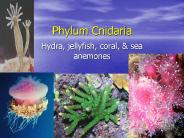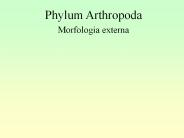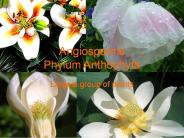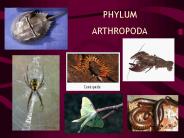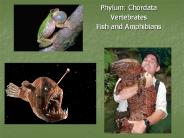Phylums PowerPoint PPT Presentations
All Time
Recommended
Phylums of Protista
| PowerPoint PPT presentation | free to view
Unit 4 - Phylums Platyhelminthes and Nematoda Flatworms and Roundworms * * Phylum Platyhelminthes Largest group of acoelomate (no body cavity) worms Flatworms with ...
| PowerPoint PPT presentation | free to view
Ch. 10,11- Phylums Platyhelminthes and Nematoda Flatworms and Roundworms Phylum Platyhelminthes Largest group of acoelomate (no body cavity) worms Flatworms with ...
| PowerPoint PPT presentation | free to view
Highly branched gastrovascular cavity runs close to all tissues giving cells ... Taenia saginata- Beef tapeworm. Live in cow muscles in cysts. High temp. kills larvae ...
| PowerPoint PPT presentation | free to view
The phylum Ascomycota belongs to the kingdom Fungi. Here you can learn something about the general characteristics, morphology, edible mushroom, reproduction, lifecycle, advantages and disadvantages of ascomycetes.
| PowerPoint PPT presentation | free to download
Phylum Annelida Phylum Annelida little ring Segmented worms 15,000 species Marine worms freshwater worms terrestrial worms Leeches worldwide distribution Soft ...
| PowerPoint PPT presentation | free to download
. Phylum Cnidaria ...
| PowerPoint PPT presentation | free to download
... Porifera Overview Most primitive of the multicellular animals There is some debate if sponges are complex colonial protozoans ... Evolution Characteristics ...
| PowerPoint PPT presentation | free to view
Phylum Cnidaria Hydra, jellyfish, coral, & sea anemones
| PowerPoint PPT presentation | free to download
... the fusion and specialization of formerly metameric segments Class Polychaeta Many are filter-feeders with specialized structures Class Polychaeta Many are ...
| PowerPoint PPT presentation | free to download
Phylum Nematoda Roundworms Roundworms monsters inside me roundworms Taxonomy Kingdom Animalia Phylum Nematoda Class Secernentea Class Adenophorea Filarial ...
| PowerPoint PPT presentation | free to view
Phylum Porifera Sponges- Pore-bearing
| PowerPoint PPT presentation | free to view
Phylum Mollusca soft bodied; many with protective shell more species of molluscs in ocean than any other phylum, over 200,000 sp. the mantle is a thin tissue layer ...
| PowerPoint PPT presentation | free to view
Phylum Platyhelminthes Simple Animals Ch. 10
| PowerPoint PPT presentation | free to view
Title: Slide 1 Author: Dana Last modified by: MIS Created Date: 10/16/2003 10:36:33 PM Document presentation format: On-screen Show Other titles: Arial Lucida Sans ...
| PowerPoint PPT presentation | free to download
Phylum Porifera General Characteristics SPONGES! Simplest of all animals _____ No true tissues or organs _____ Marine and Freshwater ...
| PowerPoint PPT presentation | free to view
Phylum Arthropoda arthro = jointed pod = foot, appendage largest phylum of animals on Earth; 3 of 4 animals are some kind of arthropod
| PowerPoint PPT presentation | free to download
Mollusca - Cobb Learning ... Phylum Mollusca
| PowerPoint PPT presentation | free to view
Phylum Arthropoda What animals are arthropods? Trilobites (Extinct!) Part of Paleozoic marine ecosystems Bodies divided into 3 long vertical lobes with many legs Most ...
| PowerPoint PPT presentation | free to download
Phylum Cnidaria Phylum Cnidaria Characteristics: Aquatic (most marine) - Radial Symmetry Have true tissues but not organs Mostly carnivorous Tentacles with stinging ...
| PowerPoint PPT presentation | free to view
Phylum PLATYHELMINTHES Platy = Flat Helminth = Worm CHARACTERISTICS All show BILATERAL symmetry Posses three tissue (germ) layers: 1.
| PowerPoint PPT presentation | free to view
Title: PowerPoint Presentation Author: del Nagle Last modified by: Coach Created Date: 1/1/1601 12:00:00 AM Document presentation format: On-screen Show
| PowerPoint PPT presentation | free to download
Phylum: Annelida - segmented worms Class: Oligochaeta Class: Polychaeta Class: Hirudinea * Phylum Annelida * Blood Sucker The salivary glands excrete hirudin which ...
| PowerPoint PPT presentation | free to view
Phylum Echinodermata Introduction There are _____ characteristics of echinoderms. All echinoderms have: Spiny skin An internal skeleton A five part body A water ...
| PowerPoint PPT presentation | free to view
Title: Kingdom Animalia Author: Cheryl Massengale Last modified by: jtaylor-lehman Created Date: 3/6/2003 10:23:50 AM Document presentation format
| PowerPoint PPT presentation | free to download
Phylum Mollusca Soft-bodied animals! 3 Classes of Molluscs GASTROPODA : includes limpets, snails, slugs and whelks BIVALVIA: includes clams, oysters, mussels ...
| PowerPoint PPT presentation | free to view
Phylum Cnidaria Cnidarian Taxonomy Phylum Cnidaria Cnidarian Taxonomy General Characteristics They are radially symmetrical; oral end terminates in a mouth ...
| PowerPoint PPT presentation | free to download
Phylum Platyhelminthes The Flatworms Phylum Platyhelminthes Characteristics Bilateral symmetry Flattened bodies 12,000+ species 1 mm to 10 m Most aquatic or parasitic ...
| PowerPoint PPT presentation | free to view
The contents of this file belongs to the purchasing school of onacd.ca. To order your own copy please visit onacd.ca.
| PowerPoint PPT presentation | free to view
Phylum : Platyhelminthes General Characteristics Free-living or parasitic Bilaterally symetrical, and dorso-ventrally flattened Epidermis has cilia or cuticle Coelom ...
| PowerPoint PPT presentation | free to view
Title: Sin t tulo de diapositiva Author: LAB-HISTOTECNIA Last modified by: martinezel Created Date: 1/2/2002 4:34:45 PM Document presentation format
| PowerPoint PPT presentation | free to download
Phylum Arthropoda insects, spiders, scorpions, ticks, mites, centipedes, millipedes, and crustaceans largest phylum in the animal kingdom; one million species ...
| PowerPoint PPT presentation | free to view
The Lophophorates Phylum Brachiopoda Phylum Bryozoa * The Lophophorates The Lophophorates * Lophophorates All are sessile or sedentary adults that feed by means of ...
| PowerPoint PPT presentation | free to view
Phylum Chordata Invertebrate Chordates Ex. Tunicates/Sea Squirts Ex. Lancelet Fishes Ectotherms (cold-blooded) Lay eggs without a shell External fertilization Jawless ...
| PowerPoint PPT presentation | free to view
Title: Phylum Nemertea & Phylum Chaetognatha Author: Marine Tech Last modified by: User Created Date: 11/25/2000 10:09:34 PM Document presentation format
| PowerPoint PPT presentation | free to view
Phylum Cnidaria Basic Info. Marine invertebrates: nearly 9000 species Made up of jellyfish, corals, sea anemones, and hydras. Found everywhere in water Prefer warmer ...
| PowerPoint PPT presentation | free to view
Phylum Annelida Learning Outcomes Students should be able to: Describe the unifying characteristics of members of phylum annelida Describe how annelids carry out ...
| PowerPoint PPT presentation | free to download
Phylum Arthropoda Subphylum Trilobita Common 500 mya (4000 spp) but extinct by 225 mya Each body segment had a biramous appendage (inner for walking) ...
| PowerPoint PPT presentation | free to download
Phylum Annelida Segmented Worms Earthworm Characteristics of Annelids Earthworms are the most highly developed worms. They are divided into segments or parts.
| PowerPoint PPT presentation | free to view
Phylum Platyhelmenthes (the flatworms) General characteristics Eumetazoa - animals with tissue Bilateria - have bilateral symmetry Head end-cephalization
| PowerPoint PPT presentation | free to download
Phylum Annelida Segmented Worms Annelids include earthworms, leeches, and polychaetes Phylum Characteristics Worldwide Coelom is well developed Closed circulation ...
| PowerPoint PPT presentation | free to view
Phylum: Mollusca Gastropods, Bivalves & Cephalopods Mollusks Mollusks are soft-bodied animals that usually have an internal or external shell. Ex.
| PowerPoint PPT presentation | free to download
Chapter 34 Section 2 Phylum Nematoda & Rotifera Phylum Nematoda Roundworms (pseudocoelomates) Bilaterally symmetrical 1mm-120mm (4 feet) Digestive tract with two ...
| PowerPoint PPT presentation | free to view
Angiosperms Phylum Anthophyta Largest group of plants Angiosperms are flowering plants. They have true roots, stems, leaves and flowers... Angiosperms are more highly ...
| PowerPoint PPT presentation | free to download
Phylum Arthropoda-Class Crustacea Shrimp Hermit Crab Daphnia Spiny Crab Characteristics Have 3 body sections-head, thorax, abdomen Sometimes the head and thorax are ...
| PowerPoint PPT presentation | free to download
Page 530 Phylum: Mollusca Snail, oyster, squid, octopus, slug, chiton Characteristics Soft body (yummy part!) Muscular system: Muscular foot (movement) Visceral mass ...
| PowerPoint PPT presentation | free to view
This is the first Phylum we study in Kingdom Animalia. The word Porifera literally translates to mean Pore Bearer Sessile, majority are marine.
| PowerPoint PPT presentation | free to view
Famiglia: Lamiaceae Ordine: Lamiales Classe: Magnoliopsida Phylum: Tracheophyta Regno: Plantae Dominio: Eukariota Lamium purpureum L. Portamento Erbe annuali/perenni ...
| PowerPoint PPT presentation | free to view
EKU General Botany lab Flowering Plants Phylum Anthophyta or Magnoliophyta OVULE DEVELOPMENT Flowering plant ovary and ovules Flowering plant megasporangium and ...
| PowerPoint PPT presentation | free to download
This is the first Phylum we study in Kingdom Animalia. The word Porifera literally translates to mean Pore Bearer Sessile, majority are marine.
| PowerPoint PPT presentation | free to view
Phylum: Cnidarians What is a Cnidarian? A cnidarian is an invertebrate It uses stinging cells to capture prey Examples: Jellyfish Corals Sea Anemones Body Structure ...
| PowerPoint PPT presentation | free to view
Phylum Arthropoda Phylum Arthropoda Several million species. Hard exoskeleton. Phylum Arthropoda: Arthropods (crustaceans, spiders, insects) Hard ...
| PowerPoint PPT presentation | free to download
Phylum: Chordata Vertebrates Fish and Amphibians Vertebrate Characteristics To be in the phylum Chordata you must have these four characteristics at some point in ...
| PowerPoint PPT presentation | free to download
... LOBSTERS, CRAYFISH, SHRIMP, KRILL & BARNACLES Over 40,000 species Appendages- highly specialized ( biological Swiss army knife ) ...
| PowerPoint PPT presentation | free to download






















